Spectra Logic’s Verde with Archive SMR drives (formerly Verde DPE and now incorporated into the existing Verde product line) is a secondary file storage platform offering solution capacities ranging from 48TB up to an eye-popping 7.1PB of raw storage. Leveraging the existing Spectra Verde Family hardware combined with Shingled Magnetic Recording (SMR) disks, the Verde offers affordable (as low as $0.075/GB) high-capacity storage for enterprise, bulk storage, archive, unstructured data, large files, random reads, bulk deletes, and files that will need infrequent changes. The Verde head units are available in both 2U or 4U form-factors, with 4U expansion shelves offered to reach the PB+ capacity ranges that few other platforms offer at this price range.

Spectra did more than simply dropping some Seagate Archive drives in the Verde and calling it an Archive storage option. For one, the Verde exclusively uses RAID Z3. While any variety of RAID can help users increase their chances of data protection, RAID Z3 should only lose data once in over two million years for the drives used in the Verde. Spectra didn’t stop there. A single stripe (20 drives plus 3 for parity) would be able to recover any lost data up to and including 3 full drive failures in one stripe. For data to actually be lost, there would have to be 4 drive failures within a fairly short window, which is statistically unlikely–to the point where “almost never” could be comfortably used.
The 20-plus-3 stripe in and of itself sounds as though it can do a fairly good job protecting data. But when claims are made about protecting data essentially forever, the company making them has to keep taking things to the next level in order to be as good as their word. Spectra also uses 2 Global Spares in each stripe. The Verde continually monitors for drive failures. When it detects one, it begins to immediately rebuild to a Global Spare. Once the rebuild is completed on the spare, an admin is notified of the bad drive. Rebuild speed is quoted at roughly 30MB/s or 70 hours. To help cut down on rebuild time, an intelligent rebuild process is used where only actual data is rebuilt versus the entire drive. The rebuild is set up in such a way that it won’t adversely affect performance, as external data movement will take priority over rebuilding the data. The utilizations of ZFS not only enable the benefits of RAID Z3, they also enable ZFS Checksums. These checksums continuously monitor for data corruption. The combination of ZFS Checksums with parity will allow the Verde to self-heal in a unique manner that other RAID solutions aren’t able to do.
While this amount of data protection limits its overall appeal to a handful of use cases, one use case that is particularly interesting (and will soon become an issue for companies across almost all industries) is bulk video storage. Surveillance used to be relegated to institutions such as the financial sector, airports, and some manufacturing. Now cameras are becoming omnipresent with a small but growing portion of people having surveillance systems in their home. The cameras aren’t being used just for security purposes either. Retail stores can monitor customer interactions with displays and products to know where to place items for the best chance of sale. While there are insights to be gained from these videos, there will also be tons of footage generated. And deriving value from this footage may not be so easy to ascertain. This footage needs to be stored for review at a later date, especially in regulated industries (like law enforcement), which may need to archive video footage for many months or longer. In these cases, the footage is less ethereal and needs to be maintained in a library that continues to grow by the day.
To get enough video surveillance data to stress-test the system with this use case in mind, we partnered with Milestone Systems. Milestone is a global leader in open platform IP video management software with over 100,000 customers worldwide. Milestone is the de facto standard when it comes to enterprise-grade video-surveillance software and offers a variety of products from software to preloaded NVRs. We used a combination of Milestone XProtect and hundreds of simulated cameras to stress the Spectra Verde and the underlying Seagate Archive HDDs in this review.
Spectra Verde specifications
- From Factor: 2U Master Node | 4U Master Node | 4U Expansion Node
- Capacity: 96TB | 200TB | Up to 800TB in 192TB increments
- Maximum System Capacity: 96TB | 7.1PB Raw (1 Master, 9 expansions)
- Connectivity: 10 Gig Base T optical | 2x10GbE optical (40GbE optional)
- HA features:
- Redundant, hot-pluggable cooling system
- Redundant power supplies, each with their own AC power connector and an LED to indicate status
- Hot-swap/spare drives
- Redundant Data On Module (DOM) drives for the operating system, logical volume manager and file system, NFS, CIFS, and SNMP servers, and the Verde web interface
- Access Protocols
- CIFS–SMB2
- NFS – NFS v3 – optional hardware kit for increased performance
- Network Monitoring and Configuration Support
- DHCP
- SNMP
- SMTP
- NTP
- Power (W): 350 active, 210 idle | 1,280 active, 1,000 idle | 775 active, 640 idle
- Performance: Up to 1GB/s
- Dimensions (WxHxD): 17.2 x 7 x 27.5 | 17.5 x 7 x 40 | 17.2 x 3.5 x 27.5 inches
- Warranty: 1-year
Design and Build
The Spectra Verde with Archive Drives is built on the same hardware chassis as the rest of the Spectra Verde line, which offers much of the same feature set and interface–but leverages traditional 7,200RPM HDDs. To position the Verde as a high-capacity and low-cost offering for archival storage needs, Spectra uses the Seagate Archive HDDs, which use SMR technology and a slower 5,900RPM spindle speed. These drives come in at a lower price point than the 7,200RPM models but are geared more to a “write few, read many” scenario that is found in archival use cases.
Enterprise Synthetic Workload Analysis
Our enterprise NAS benchmark process preconditions each device into steady-state with the same workload the device will be tested with under a heavy load of 16 threads, with an outstanding queue of 16 per thread. The device is then tested in set intervals in multiple thread/queue depth profiles to show performance under light and heavy usage. Since CIFS tests reach their rated performance levels very quickly, we only graph out the main sections of each test.
Preconditioning and Primary Steady-State Tests:
- Throughput (Read+Write IOPS Aggregate)
Our Enterprise Synthetic Workload Analysis includes four profiles based on real-world tasks. These profiles have been developed to make it easier to compare to our past benchmarks, as well as widely-published values such as max 4K read and write speed as well as sequential 8K and 128K throughput and bandwidth, which is commonly measured in the enterprise.
- 4K
- 100% Read or 100% Write
- 100% 4K
- 8K (Sequential)
- 100% Read or 100% Write
- 100% 8K
- 128K (Sequential)
- 100% Read or 100% Write
- 100% 128K
While the primary use case as a backup target is a sequential workload, depending on the number of systems hitting the target at a given point, those multiple streams could look like a random workload to the underlying storage. So while 128K sequential bandwidth is the main metric to take note of in the synthetic testing, 4K random and 8K sequential metrics can be helpful to consider. This is especially true in the case where the Verde may be used for something like surveillance primarily, but could also be used by an enterprise for other applications, even if not specifically designed to address those in an ideal manner.
For 4K throughput, the Verde gave us read performance of 279 IOPS and 1,012 IOPS write.
Looking at 8K 100% Read/Write throughput, the Verde gave us a performance of 41,847 IOPS read and 26,411 IOPS write.
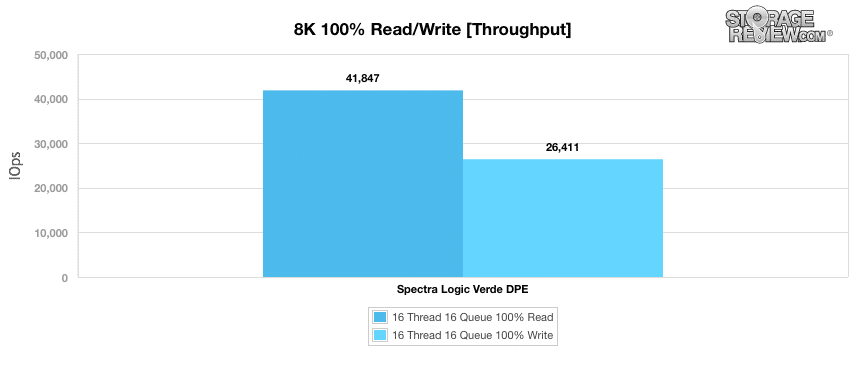
Switching over to our large block 128K, we saw sustained write speeds of 260.3MB/s and read speeds of 1.07GB/s.
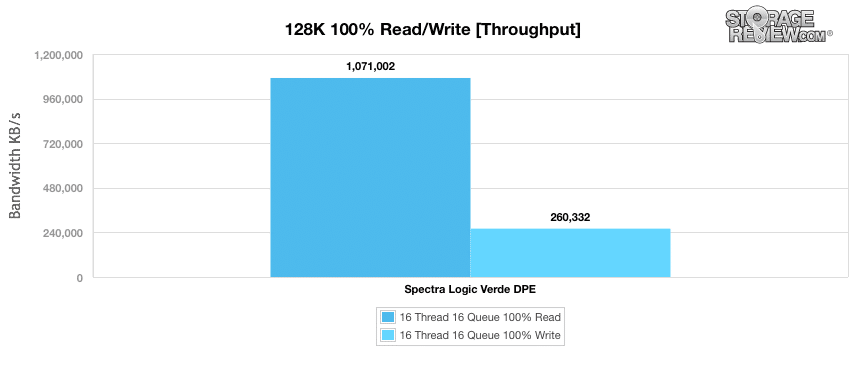
While synthetic benchmarks are a commonality in our reviews, they don’t always paint the clearest picture as to how the device will perform in the real world. And in several of our reviews we run application workload analysis benchmarks. In lieu of that, we took an actual simulated use case to test the performance of the Spectra Verde.
The environment included the flagship Milestone product XProtect Corporate 2016 with 440 virtual cameras.
XProtect Corporate is powerful IP video management software (VMS) designed for large-scale and high-security deployments. Its unified-management interface enables efficient administration of the system, including all cameras and security devices, regardless of the system’s size or if it is distributed across multiple sites. For systems demanding supreme situational awareness and precise response to incidents, XProtect Corporate can include Milestone XProtect Smart Wall. XProtect Corporate features include advanced video grooming functions and encryption capabilities that help organizations reduce video storage costs, while ensuring the integrity of video evidence and complying with industry and federal regulations.
The multi-tier storage architecture was built upon XProtect’s archiving feature. Each Recording Server was configured to record all 110 cameras continuously into the direct-attached Live Database. Our local storage consisted of two Toshiba PX04 NVMe SSDs inside a Supermicro server, leveraging Intel Broadwell E5-2699 v4 CPUs with 384GB of RAM. At the top of each hour, the Recording Servers were scheduled to transfer any video older than 2 hours in the Live Database onto the Verde array for permanent storage in the Archive Database. It is important for the long-term health of both the XProtect system and the Verde array that these Archive Events (where the video is read from the Live Database and written to the Archive Database) are discrete (as seen in the figure below). If the Archive Events take too long to complete, the XProtect system risks overflowing the Live Database and dropping frames of video or recording over video before its retention period has expired. Additionally, the Verde system requires periods of idle disk activity, where the SMR HDDs can recover from heavy write workloads.
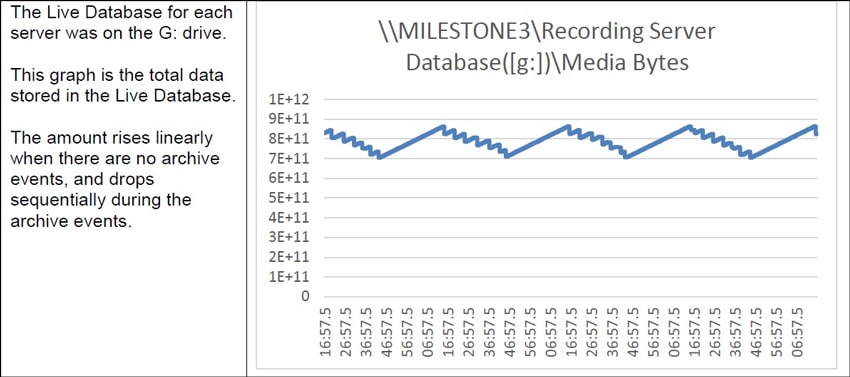
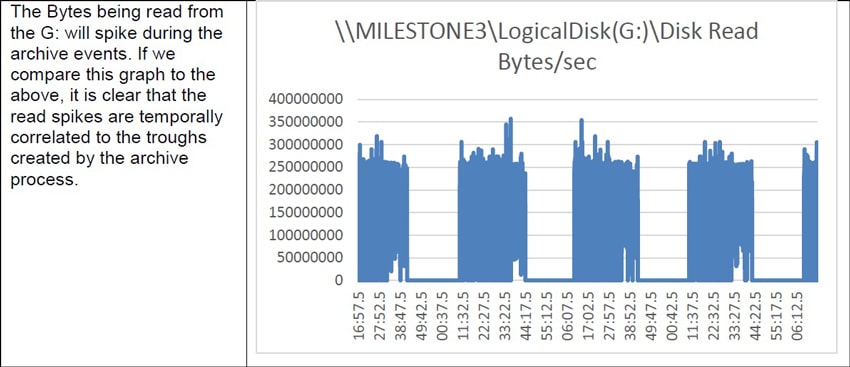
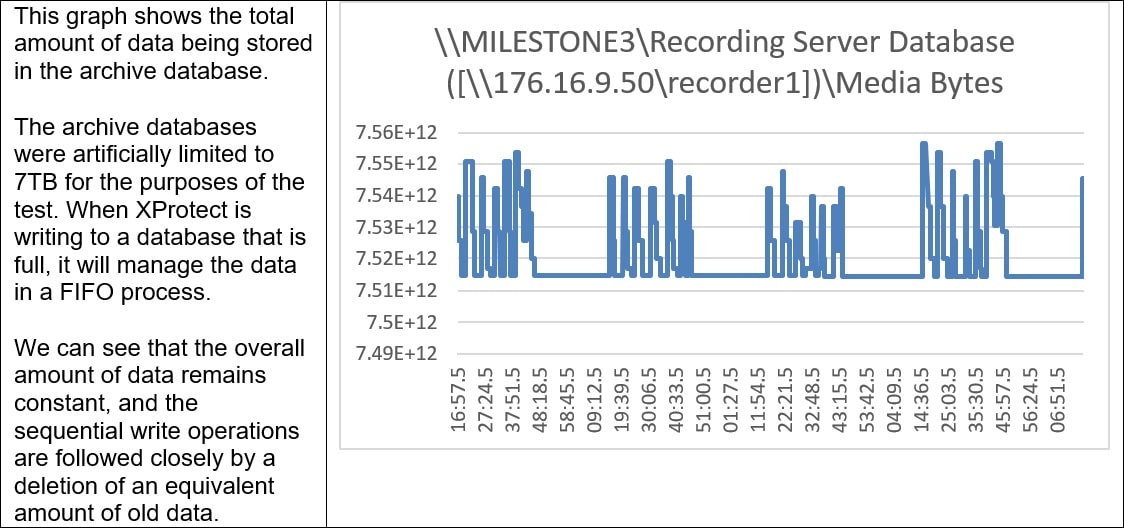
The software and VM topology of the system included one VM hosting the XProtect Corporate Management Server, the Management Client for administration of the entire system and the XProtect Smart Client used to view live and recorded video. There were four high performance VMs, each supporting an XProtect Recording Server connected to and recording 110 virtualized camera streams. The camera streams were approximately 5Mbps each. This creates a total system ingest of over 2Gbps.
With 440 cameras running we took a sample of 25 hours in order to see the write performance on the Verde. The cameras peaked around 630MB/s. One can see when the cameras were shut down during testing as the performance dropped to 0.
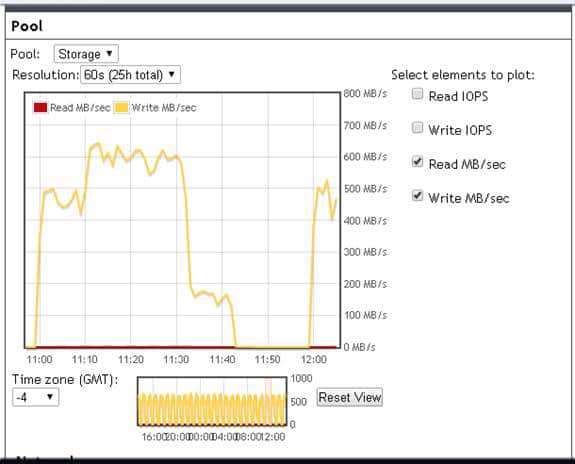
Drilling in to a single hour, we can see the write performance staying fairly steady, just north of 600MB/s.
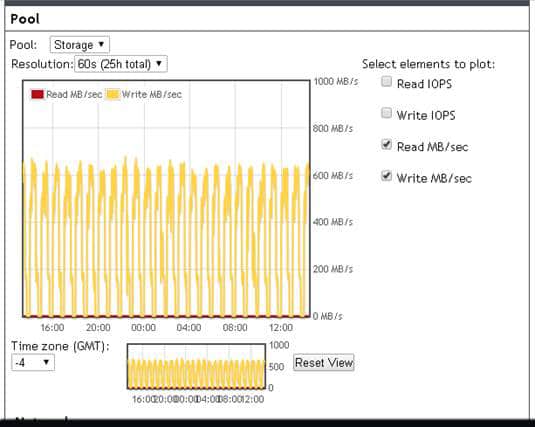
Again, taking this one step further to five minutes, we can see that write performance bounced between 400MB/s and around 900MB/s with an average just above 600MB/s.
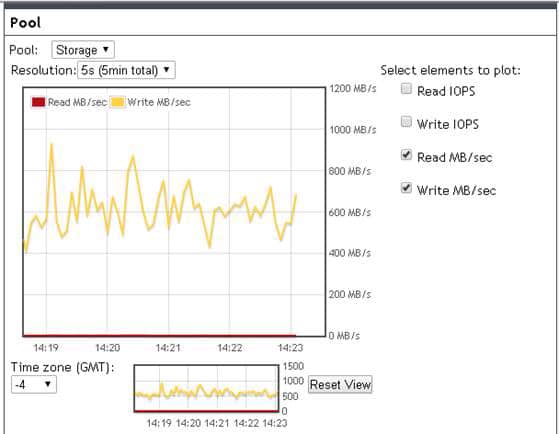
Conclusion
The Spectra Verde Family is a 2U or 4U NAS designed specifically for archiving and for large data storage. The Verde with Archive Drives leverages SMR HDD technology using Seagate’s 8TB Archive HDDs. The company leveraged SMR technology and integrated it with its own archive technology to unlock the full potential of SMR. What’s interesting is that Spectra saw the perfect use case for SMR and adopted this use case into its matching technology to deal with increasing footprints of this data type without changing the way storage is consumed in the enterprise.
As such, the Verde has a narrow set of use cases and it is important to see that our tests reflect these use cases. To run our normal gamut of application benchmarks doesn’t make sense in this case. For example, if we tested this NAS with multi-tenant and varied workloads, it obviously would not perform all that well. The Spectra Verde is designed specifically for taking large amounts of data and writing it to a medium where it will stay for a long time with little to no access. This puts the Verde more the in tape replacement business than a full-fledged primary storage NAS.
To that end, we paired with Milestone to do the bulk of the testing, showing the Verde in its native environment. Leveraging Milestone to orchestrate 440 virtual cameras, we created an environment that’s similar to what a mid-sized casino or perhaps a municipality may use. We amped up the recorder server with a large RAM footprint and NVMe storage, to ensure we provided the Verde as wide a fire hose as possible to ingest. The bottom line is that the system happily consumed the write events as the recording server filled up, chugging in the data at about 600MB/s. In fact, the Verde could probably handle more, we just topped out other resources in our test environment.
Spectra Logic has done something pretty neat here with the Verde. They’ve designed around a new HDD technology that’s specifically architected to favor near-constant sequential writes that aren’t changed much over time, very similar to the profile of tape. In the surveillance use case we designed around, the execution is perfect, the Verde does precisely what it is supposed to. Pair this execution with RAID Z3 availability and the pricing per TB benefits of the HDDs, and the Verde is a top-class solution for this and similar workloads.


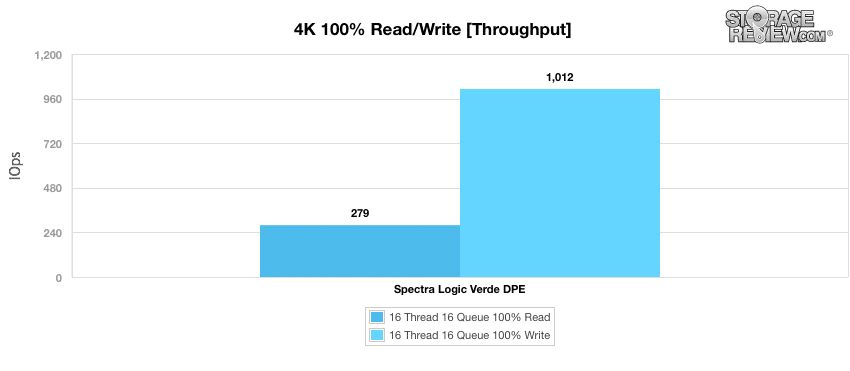


 Amazon
Amazon